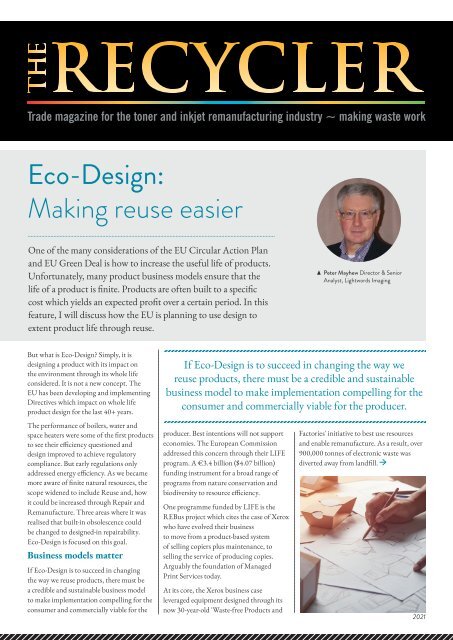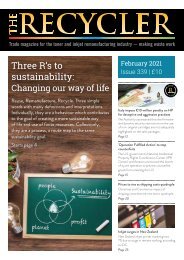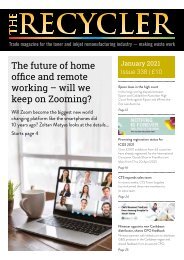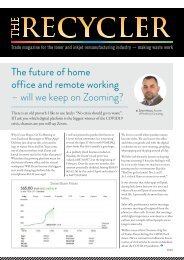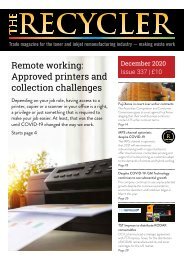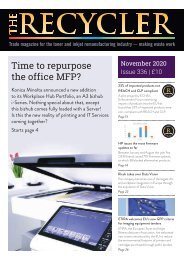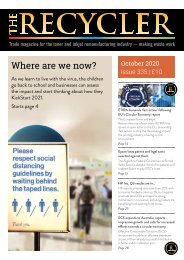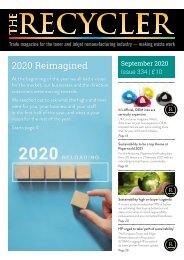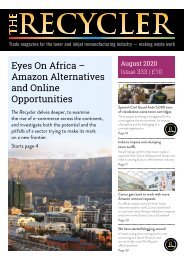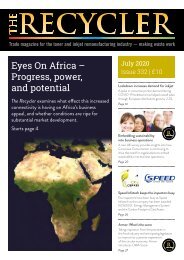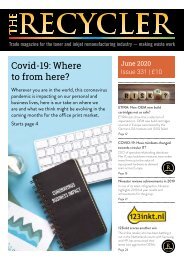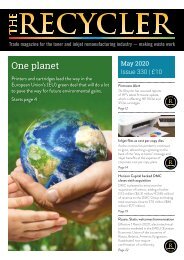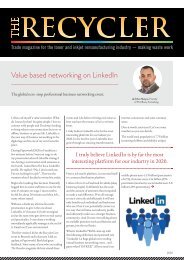The Recycler - Eco Design
Create successful ePaper yourself
Turn your PDF publications into a flip-book with our unique Google optimized e-Paper software.
<strong>Eco</strong>-<strong>Design</strong>:<br />
Making reuse easier<br />
One of the many considerations of the EU Circular Action Plan<br />
and EU Green Deal is how to increase the useful life of products.<br />
Unfortunately, many product business models ensure that the<br />
life of a product is finite. Products are often built to a specific<br />
cost which yields an expected profit over a certain period. In this<br />
feature, I will discuss how the EU is planning to use design to<br />
extent product life through reuse.<br />
▲ Peter Mayhew Director & Senior<br />
Analyst, Lightwords Imaging<br />
But what is <strong>Eco</strong>-<strong>Design</strong>? Simply, it is<br />
designing a product with its impact on<br />
the environment through its whole life<br />
considered. It is not a new concept. <strong>The</strong><br />
EU has been developing and implementing<br />
Directives which impact on whole life<br />
product design for the last 40+ years.<br />
If <strong>Eco</strong>-<strong>Design</strong> is to succeed in changing the way we<br />
reuse products, there must be a credible and sustainable<br />
business model to make implementation compelling for the<br />
consumer and commercially viable for the producer.<br />
<strong>The</strong> performance of boilers, water and<br />
space heaters were some of the first products<br />
to see their efficiency questioned and<br />
design improved to achieve regulatory<br />
compliance. But early regulations only<br />
addressed energy efficiency. As we became<br />
more aware of finite natural resources, the<br />
scope widened to include Reuse and, how<br />
it could be increased through Repair and<br />
Remanufacture. Three areas where it was<br />
realised that built-in obsolescence could<br />
be changed to designed-in repairability.<br />
<strong>Eco</strong>-<strong>Design</strong> is focused on this goal.<br />
Business models matter<br />
If <strong>Eco</strong>-<strong>Design</strong> is to succeed in changing<br />
the way we reuse products, there must be<br />
a credible and sustainable business model<br />
to make implementation compelling for the<br />
consumer and commercially viable for the<br />
producer. Best intentions will not support<br />
economies. <strong>The</strong> European Commission<br />
addressed this concern through their LIFE<br />
program. A €3.4 billion ($4.07 billion)<br />
funding instrument for a broad range of<br />
programs from nature conservation and<br />
biodiversity to resource efficiency.<br />
One programme funded by LIFE is the<br />
REBus project which cites the case of Xerox<br />
who have evolved their business<br />
to move from a product-based system<br />
of selling copiers plus maintenance, to<br />
selling the service of producing copies.<br />
Arguably the foundation of Managed<br />
Print Services today.<br />
At its core, the Xerox business case<br />
leveraged equipment designed through its<br />
now 30-year-old 'Waste-free Products and<br />
Factories' initiative to best use resources<br />
and enable remanufacture. As a result, over<br />
900,000 tonnes of electronic waste was<br />
diverted away from landfill.<br />
2021
Cambridge Value Mapping Tool<br />
<strong>The</strong> Cambridge Value Mapping<br />
Tool takes you in a guided step-bystep<br />
process through the following<br />
questions:<br />
1. What is the unit of analysis<br />
eg product, service, company,<br />
industry?<br />
2. Who are the stakeholders<br />
for the unit of analysis?<br />
3. What is the purpose of<br />
the unit of analysis?<br />
4. What is the current value<br />
captured?<br />
5. What is the value missed<br />
and/or destroyed?<br />
6. What is the value surplus<br />
and/or absence?<br />
7. What are the new value<br />
opportunities?<br />
Source: http://www.ifm.eng.cam.ac.uk/news/thecambridge-value-mapping-tool/# .V8aiy5N961s<br />
However, new business model design<br />
tools are needed to redefine value and<br />
one example is the work of the University<br />
of Cambridge in the UK who, through<br />
its Industrial Sustainability Research<br />
have created <strong>The</strong> Cambridge Value<br />
Mapping Tool. <strong>The</strong> tool "uses a structured<br />
and visual approach to identify ‘value<br />
uncaptured’ in the form of failed value<br />
exchanges: value missed, destroyed,<br />
surplus, and absence. <strong>The</strong> exchange<br />
of value is analysed through the lens<br />
of each stakeholder in the business<br />
network, with the natural environment<br />
and society each being given its own<br />
voice and stake in the business ".<br />
<strong>Design</strong> for sustainability<br />
and reuse<br />
<strong>The</strong>re are many opportunities during<br />
the new product design (NPD) process<br />
to reduce the environmental impact of<br />
a product; the choice and quantity of<br />
material used, how it is formed, the layout<br />
of the construction to achieve structural<br />
or aesthetic requirements, the method of<br />
assembly to achieve functionality or, the<br />
Second, third or multiple reuses is not a new<br />
design concept. <strong>The</strong>re are many examples,<br />
from cars to clocks, where repair requires<br />
a few simple tools and, if you cannot buy<br />
a spare part, you can make it yourself!<br />
type of fixings used to achieve assembly,<br />
durability, and safety. <strong>Design</strong> processes<br />
now often include consideration of<br />
product failure to achieve higher quality<br />
and reliability over a specific time, for a<br />
specified value proposition. Environmental<br />
impact has some way to go to achieve<br />
similar treatment.<br />
Second, third or multiple reuses is not<br />
a new design concept. <strong>The</strong>re are many<br />
examples, from cars to clocks, where<br />
repair requires a few simple tools and,<br />
if you cannot buy a spare part, you can<br />
make it yourself! Additive manufacturing<br />
leveraging 3D printing technology will<br />
revolutionize the repair sector. But product<br />
design must also ensure that the end user<br />
does not come to harm or cause injury on<br />
the pathway to end of life and the next sale.<br />
Safe dismantling requires a product<br />
designed for dis-assembly including,<br />
Commonly Used Fasteners which<br />
can be removed and replaced multiple<br />
times, elimination of non-separable<br />
connections (use of glues and welds)<br />
and, levels of skills for disassembly and<br />
reassembly which do not always require<br />
extensive training and expertise to replace<br />
worn parts.<br />
However you consume your news make sure you engage: Like, Follow and Share
<strong>The</strong>re are <strong>Eco</strong>-<strong>Design</strong> minimum<br />
requirements for some products<br />
(computers, household appliances, boilers,<br />
etc.) which are intended to reduce their<br />
negative environmental impact during<br />
their life. <strong>The</strong>ir scope can be broad and<br />
include maximum energy consumption to<br />
minimum quantities of recycled material<br />
used in their production. Increasingly, there<br />
are specific and exact values attributed to<br />
these requirements. Generic requirements<br />
do not have limits but, may require<br />
products to be recyclable, maintainable<br />
and minimize environmental impact.<br />
Sometimes, compliance is required before<br />
the product is placed on the market.<br />
Implementing standards<br />
<strong>The</strong> EU also provides design standards<br />
which are regulated. European<br />
standardisation bodies such as CENELEC<br />
develop Standards and Harmonization<br />
processes. But there can be a presumption<br />
of conformity and compliance.<br />
Presumption may not always be effective,<br />
and some industry sectors create Voluntary<br />
Agreements under the EU <strong>Eco</strong>-<strong>Design</strong><br />
legislation. Imaging equipment is covered<br />
by an Industry Voluntary Agreement,<br />
managed through Eurovaprint, providing<br />
environmental performance targets.<br />
It includes copiers, MFDs, printers<br />
and fax machines.<br />
Plastic is an extremely versatile product,<br />
but its ubiquitous use is now recognised as<br />
unsustainable, polluting, and harmful to<br />
the environment. Imaging equipment, like<br />
numerous similar products make ample<br />
use of the material.<br />
It is positive to note that the latest draft<br />
of the 2020 Joint Voluntary Agreement<br />
sets specific requirements for the use of<br />
plastic, fastener types, and non-separable<br />
connections in both print hardware and<br />
cartridges.<br />
This Voluntary Agreement goes a step<br />
further to discuss dismantling and nondestructive<br />
extraction of some components<br />
which are typically separated at the end<br />
of the product life. <strong>Eco</strong>-labeling will<br />
demonstrate compliance to end-users. This<br />
is a good example of how the EU Circular<br />
Action Plan and Green Deal, through <strong>Eco</strong>-<br />
<strong>Design</strong> is slowly starting to have an impact<br />
on an industry.<br />
<strong>Eco</strong>-<strong>Design</strong> is not difficult to achieve.<br />
Its problem is that it is caught between<br />
economic, commercial, and environmental<br />
stakeholder needs. Either Voluntary<br />
industry direction or legal compulsion<br />
will decide the degree and pace of<br />
its implementation in many industries.<br />
Post pandemic, competitive advantage<br />
through <strong>Eco</strong>-<strong>Design</strong> will resonate<br />
well with customers and may prove<br />
a welcome accelerant.<br />
References:<br />
<strong>The</strong> REBus Project: www.rebus.eu.com<br />
University of Cambridge. Industry<br />
Sustainability Research: www.ifm.eng.cam.<br />
ac.uk/research/industrial-sustainability/<br />
CELENEC European Committee for<br />
Electromechanical Standardization:<br />
www.cenelec.eu<br />
EuroVAPrint: www.eurovaprint.eu ■<br />
However you consume your news make sure you engage: Like, Follow and Share


